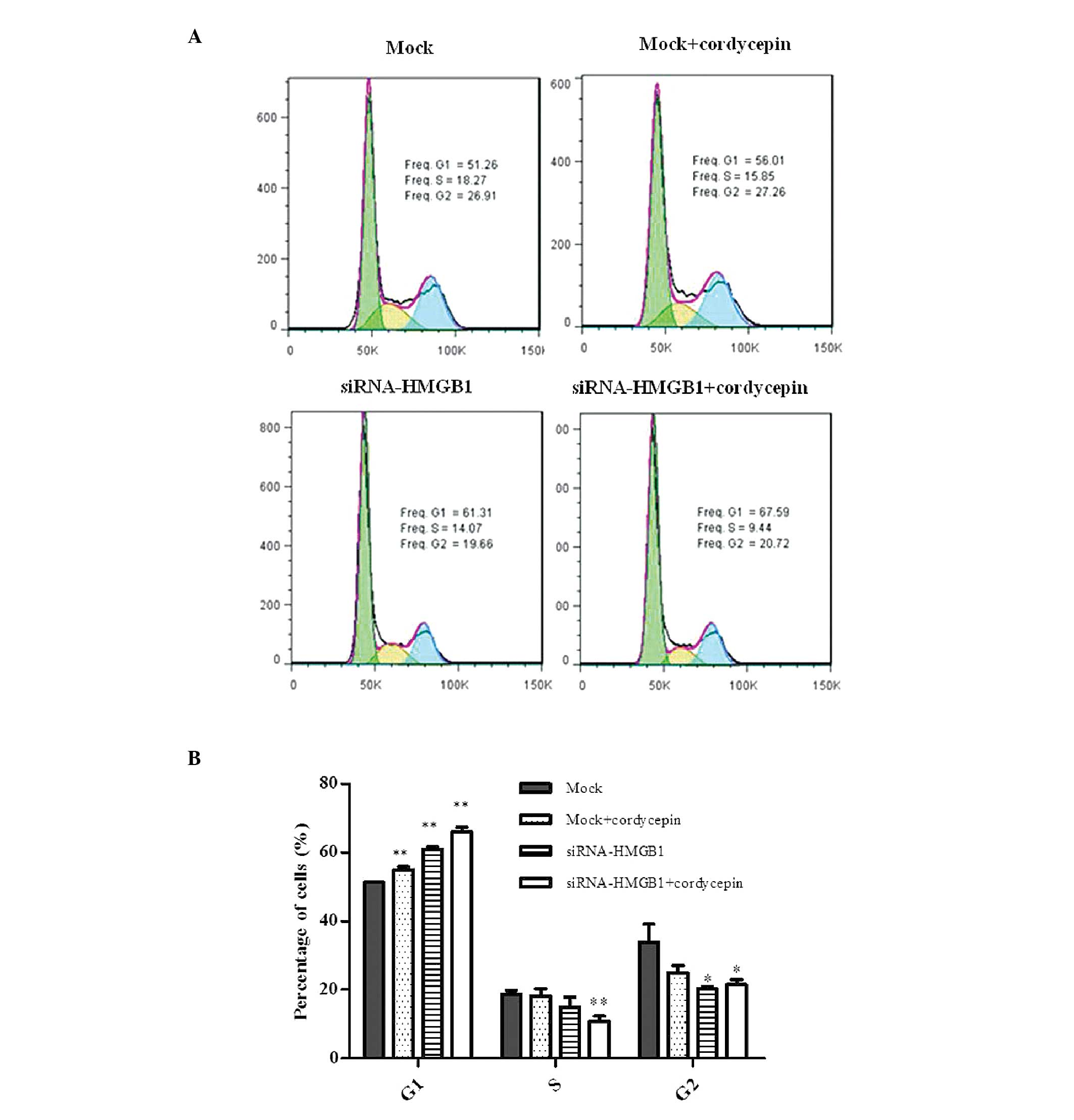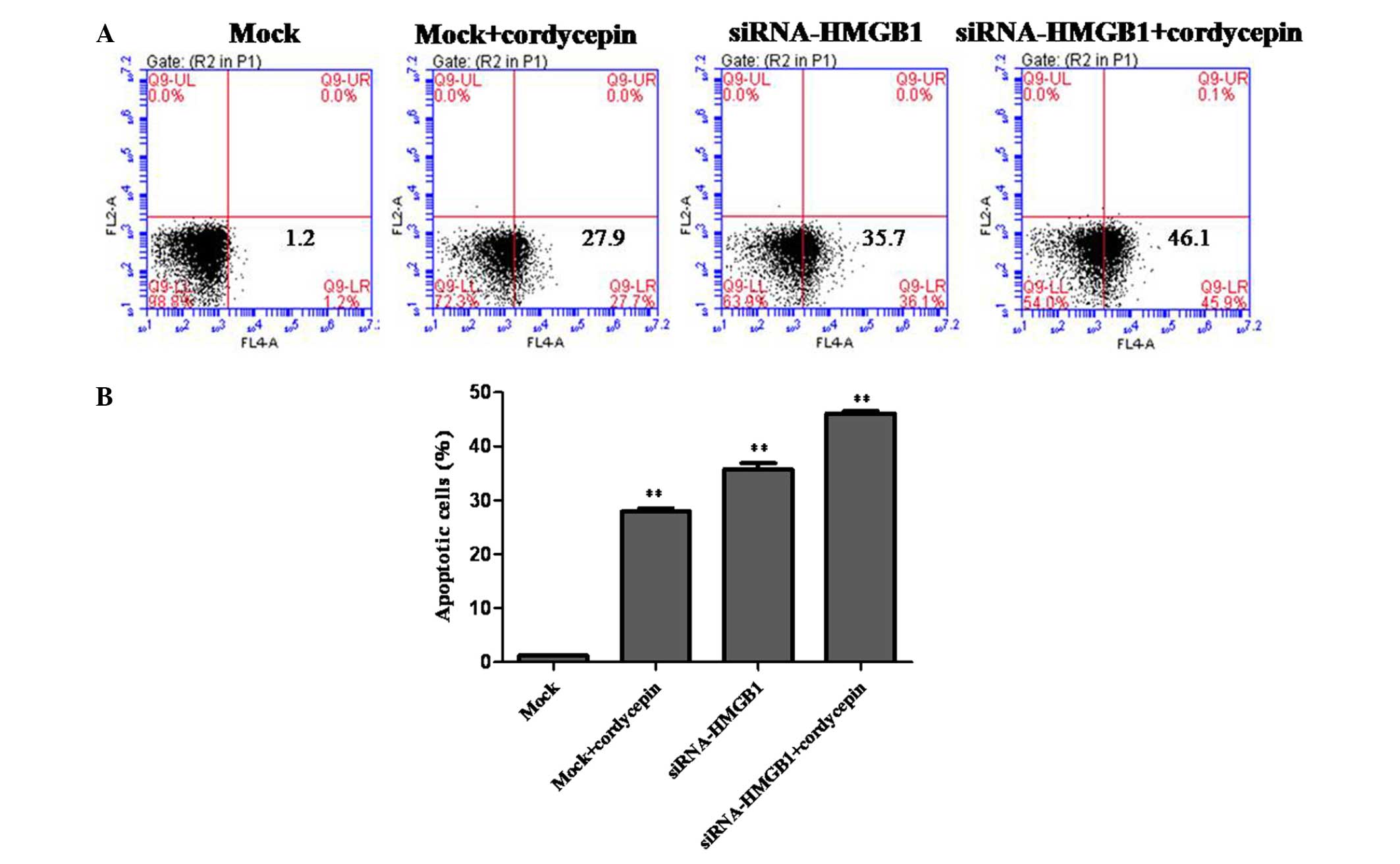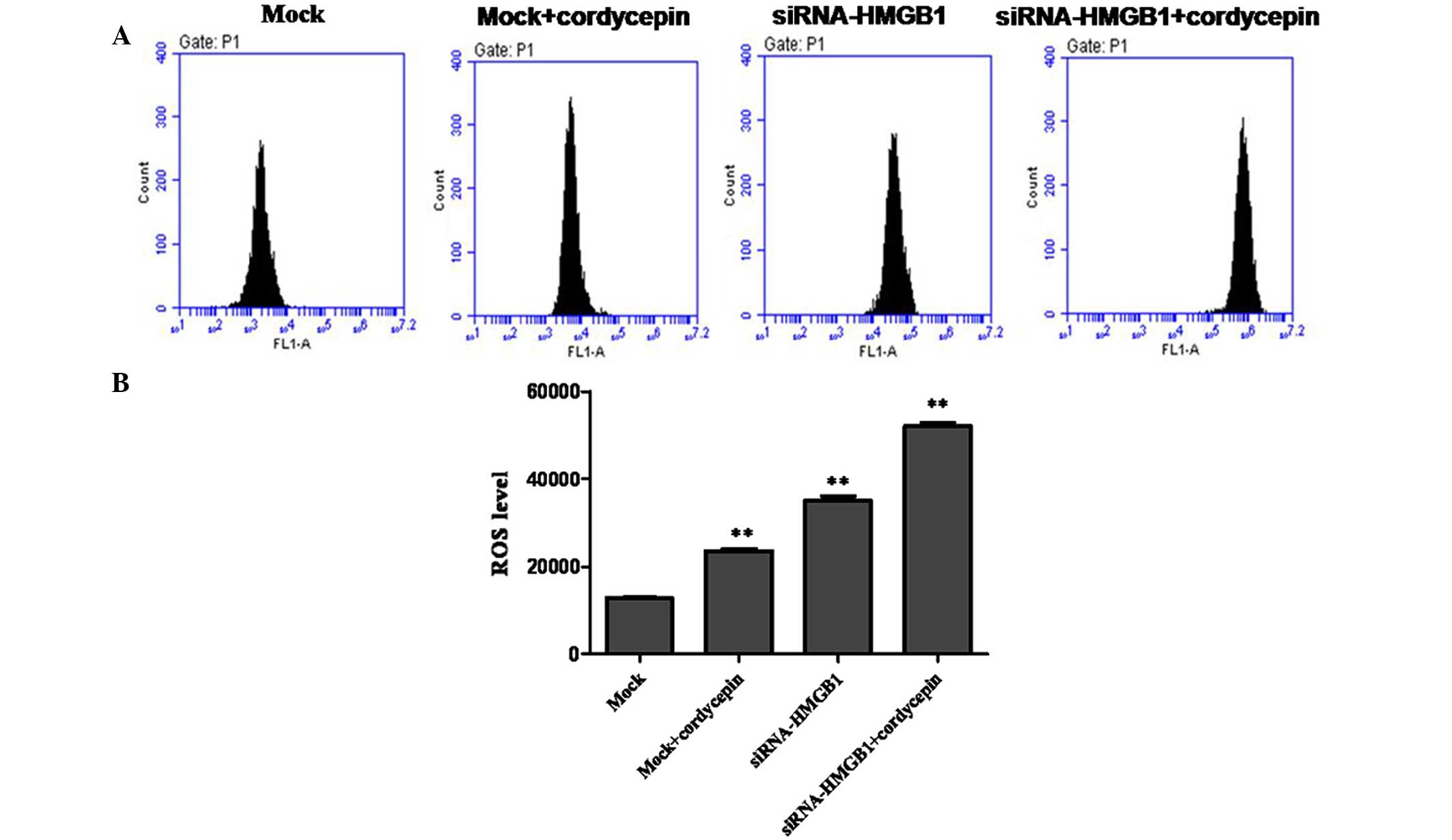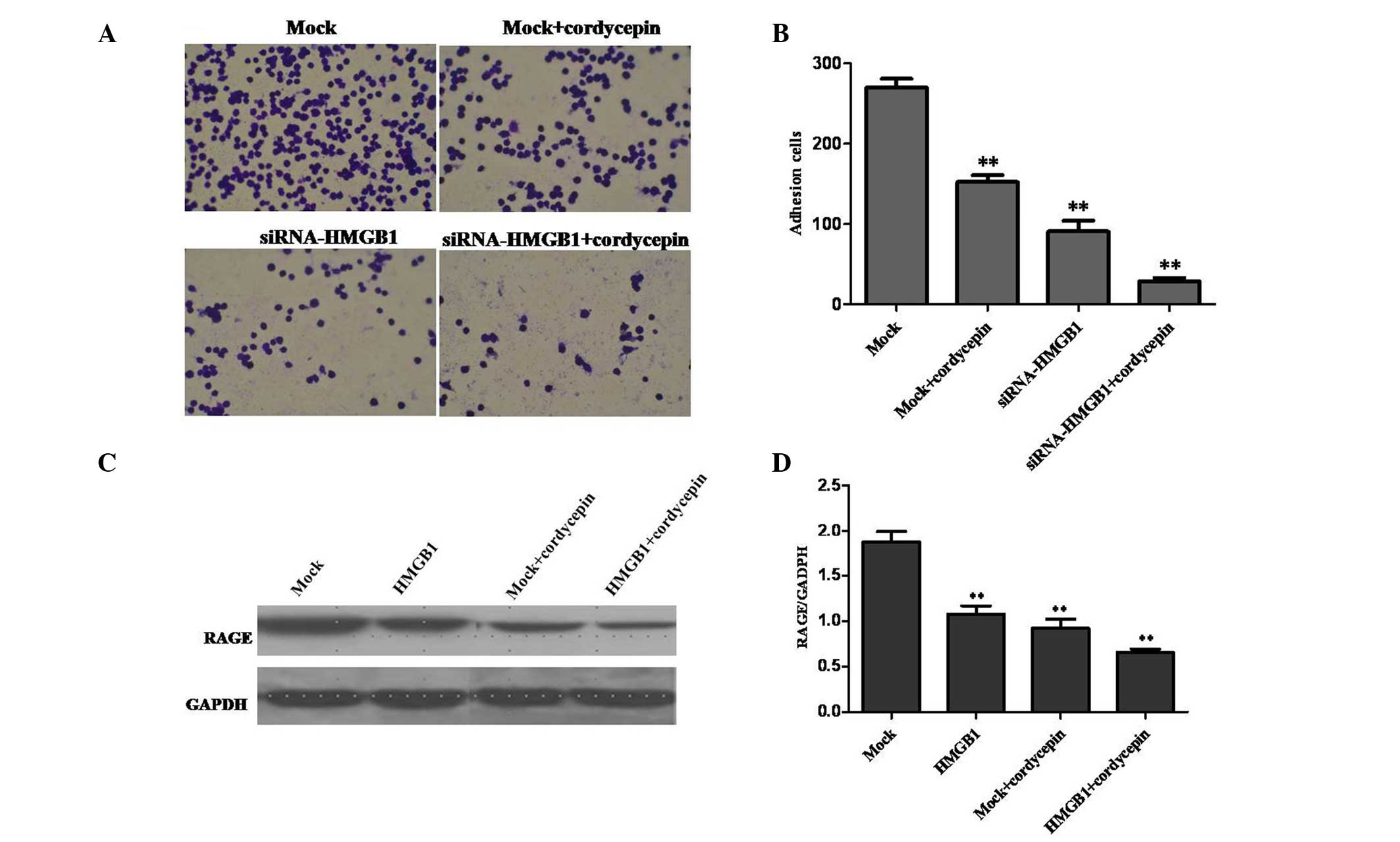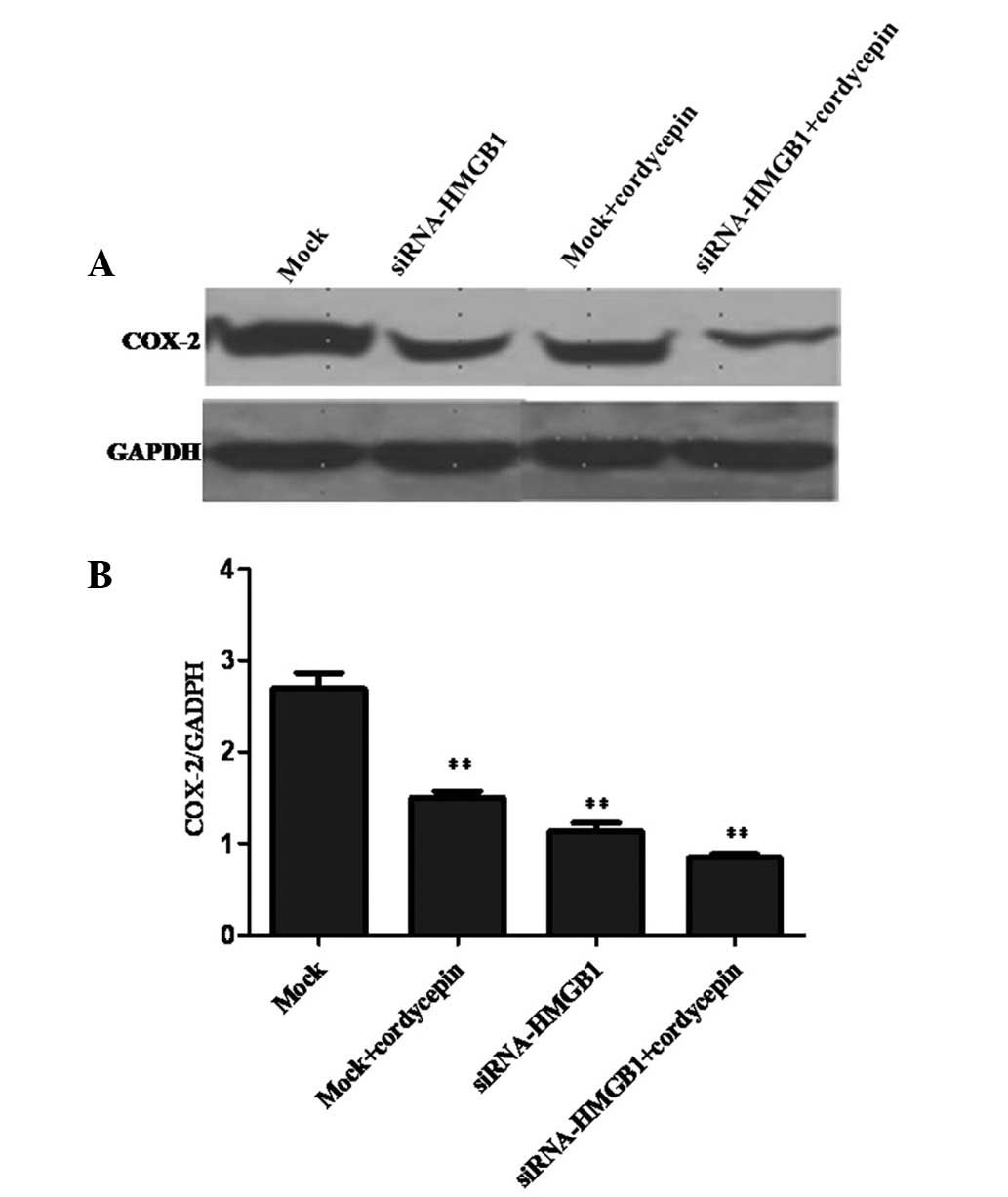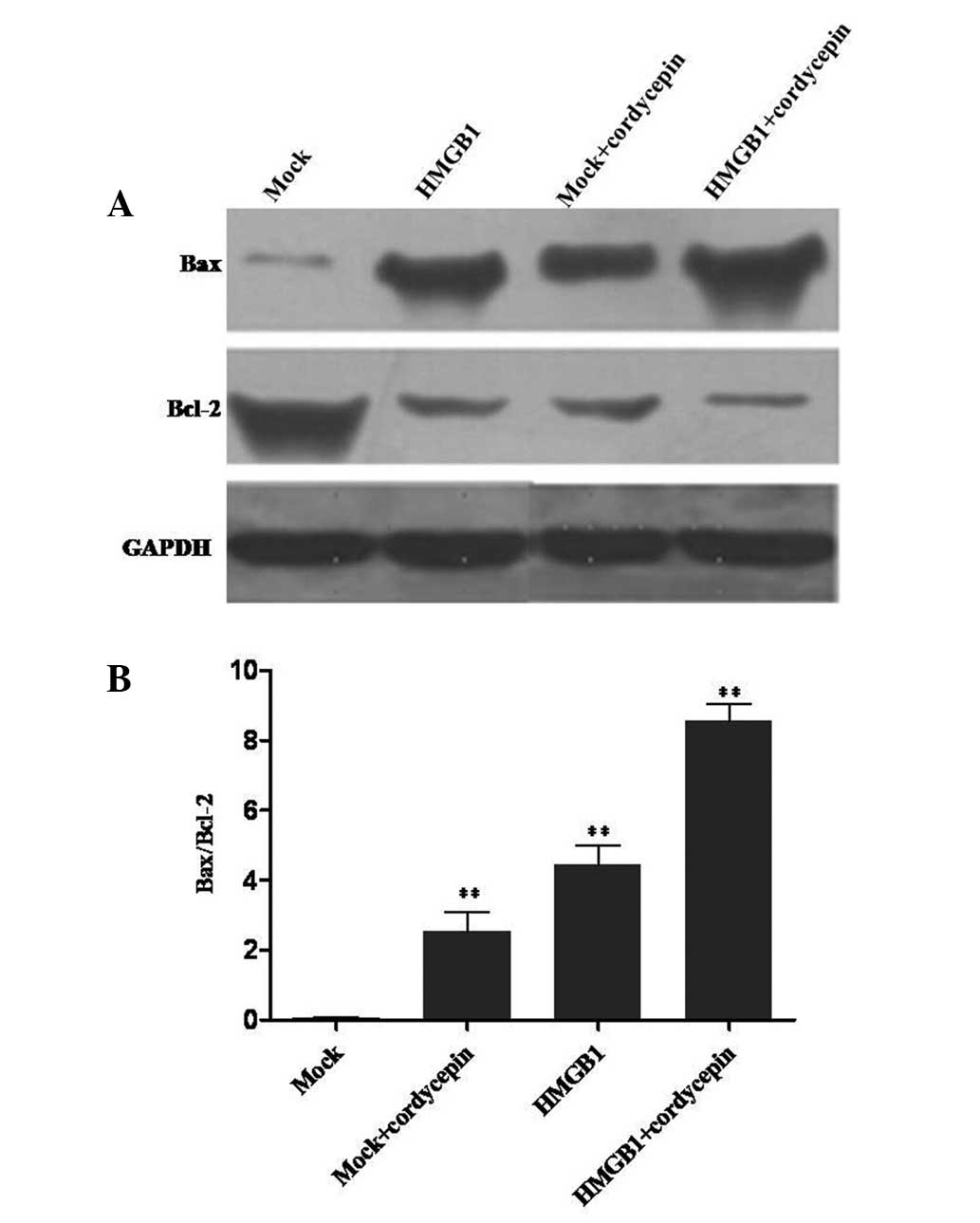Synergistic effect of HMGB1 knockdown and cordycepin in the K562 human chronic myeloid leukemia cell line
- Authors:
- Published online on: June 15, 2015 https://doi.org/10.3892/mmr.2015.3928
- Pages: 4462-4468
Abstract
Introduction
Chronic myeloid leukemia (CML) is a hematopoietic stem cell disorder; which has serious implications on health and life expectancy (1). It is diagnosed by the presence of a specific abnormality karyotype Philadelphia (Ph) chromosome, harboring the BCR-ABL oncogene (2). CML follows progression from a chronic phase to an accelerated phase or to a rapidly fatal blast crisis within 3–5-years in patients (3). It has been reported that imatinib, nilotinib and dasatinib can be used in the treatment of patients with CML (4). At present, treatment strategies for leukemia remain unsatisfactory, thus it is imperative to fully elucidate the molecular mechanisms of leukemia. It will be undoubtedly a general trend that molecular therapy combined with anti-leukemia natural compound are employed in leukemia treatment (5).
High mobility group box 1 (HMGB1), a DNA-binding nuclear protein predominantly involved in the inflammatory response, has a close association with the growth of tumor cells, invasion and metastasis (6,7). It is the prototypic damage-associated molecular pattern (DAMP) molecule and has been implicated in several inflammatory disorders (8). High levels of HMGB1 have been previously detected in leukemia cells (9). HMGB1 is known to be a type of anti-apoptotic binding protein and its over-expression is able to inhibit cell apoptosis, leading to the occurrence of leukemic growth (10). The upregulation of HMGB1 mRNA expression has been identified in a number of tumor types (11–13). In addition, HMGB1 has been reported to reduce the sensitivity of K562 human myeloid leukemia cells to anticancer drugs (14). Therefore, targeting the HMGB1 ligand or its receptor represents an important potential application in leukemia therapy. Cordycepin (3′-deoxyadenosine) is a key bioactive component isolated from C. militaris. It has been reported to possess numerous pharmacological activities, including immunological stimulation, anticancer and antileukemic effects (15–17). Previous studies have indicated that cordycepin has a range of molecular targets and influences numerous biochemical and molecular processes (18–20). However, the molecular mechanisms of cordycepin on leukemia remain to be fully elucidated.
In the present study, HMGB1 knockdown cells were established using the lentiviral infection method. The effects of HMGB1 knockdown in combination with cordycepin treatment on proliferation, apoptosis, reactive oxygen species (ROS) and adhesion of the K562 leukemia cell line were evaluated. In addition, whether cordycepin exhibited synergistic action with the HMGB1 knockout was investigated, which aimed to provide insight into CML treatment.
Materials and methods
Cell culture, transfection and treatment
The K562 and 293T human CML cell lines were purchased from the American Type Culture Collection (Manassas, VA, USA) and cultured in Dulbecco's modified Eagle's medium (DMEM; Invitrogen Life Technologies, Carlsbad, CA, USA) containing 10% (v/v) heat-inactivated fetal bovine serum (FBS; Gibco Life Technologies- Carlsbad, CA, USA), 100 mg/ml streptomycin and 100 U/ml penicillin (Beyotime Institute of Biotechnology, Haimen, China) at 37°C in a humidified 5% CO2 atmosphere. Cells with HMGB1 high-expression were screened for transfection by means of western blotting. The small interfering RNA (siRNA)-HMGB1 plasmid was provided by JRDUN Biotechnogy (Shanghai) Co., Ltd. (Shanghai, China). The HMGB1 plasmid (3 mg) or mock-vehicle were transfected into K562 cell lines in 6-well plates (1 mg/ml) using the pCMV-G-NR-U6-shRNA lentiviral vector (Shanghai Genechem Co., Ltd., Shanghai, China), according to the manufacturer's instructions. Cells were treated with cordycepin (30 μmol/l) for 48 h, and then were subjected to cell assays.
Cell viability assay
For the cell viability assay, cells (5×105/ml) were seeded into 96-well plates and cultured for 0, 24, 48 and 72 h at 37°C. Subsequently, 100 μl serum free DMEM containing 10% Cell Counting kit-8 (CCK-8; Beyotime Institute of Biotechnology) reagent (v/v) was added into each well and the cells were cultured for 1 h in 5% CO2 at 37°C. Finally, optical density values (OD) were read at 450 nm using a SpectraMax® i3× microplate reader (Molecular Devices, Sunnyvale, CA, USA).
Detection of cell cycle and apoptosis by flow cytometric analysis
The cell cycle was assessed according to the percentage of cells with DNA using the propidium iodide (PI) staining technique. With or without cordycepin treatment for 48 h, cells (5~10×104) were harvested and stained using an Annexin V-fluorescein isothiocyanate/PI kit (BD Biosciences, Franklin Lakes, NJ, USA). Staining was performed according to the manufacturer's instructions. The apoptosis of K562 cells was determined by flow cytometric analysis using a FACSCaliber flow cytometer (BD Biosciences).
Detection of ROS
The generation of ROS was assessed by flow cytometry. In brief, cells (5×104 cells/well) were cultured and washed with phosphate-buffered saline (PBS) and resuspended in complete medium followed by incubation with 50 μM dihydrorhodamine (DHE; Vigorous Biotechnology, Beijing, China) for 30 min at 37°C. ROS fluorescence intensity was determined by flow cytometry with excitation at 490 nm and emission at 520 nm.
Cell adhesion assay
The cell adhesion assay was conducted in 12-well plates according to the method described previously (21). The wells were precoated with fibronectin (Sigma-Aldrich, St. Louis, MO, USA) overnight at room temperature. K562 cells were harvested and re-suspended in DMEM containing 10% FBS; then, cells were added (2×105/well) to each well and incubated at 37°C for 1 h. The wells were washed twice with warm PBS to remove the unattached cells, and the attached cells were fixed with methanol for 15 min and stained with crystal violet (Sigma-Aldrich) for 20 min. Subsequent to staining, the cells were observed using an optical BX51 microscope (Olympus, Tokyo, Japan).
Western blot analysis
Following the above treatments, cells were harvested and lysed in radioimmunoprecipitation assay buffer (Beyotime Institute of Biotechnology) and protease inhibitor cocktail (Sigma-Aldrich) for 10 min at 4°C. The protein concentration was determined using Bicinchoninic Acid Protein Assay Reagent (Thermo Fisher Scientific, Waltham, MA, USA). Subsequently, equal quantities of denatured protein (20 μg) were separated on 10% SDS-PAGE gels (Beyotime Institute of Biotechnology), then transferred to nitrocellulose membranes (Pall Corporation, Pensacola, FL, USA) and incubated overnight at 4°C with a cyclooxygenase 2 (COX-2, Abcam, Cambridge, MA, USA, cat. no. Ab62331, 1:500), receptor for advanced glycation end products (RAGE, Abcam, cat. no. Ab54741, 1:1,000), Bax (Santa Cruz Biotechnology, Inc., Dallas, TX, USA, cat. no. Sc-493, 1:150) and Bcl-2 (Santa Cruz Biotechnology, Inc., cat. no. Sc-492, 1:100) monoclonal primary antibodies, followed by incubation with a goat anti-mouse/horseradish peroxidase conjugated secondary antibody and chemiluminescence detection (ECL; Millipore, Billerica, MA, USA). To ensure equivalent protein loading, antibodies targeted against GAPDH were used, and the protein expression levels were normalized to GAPDH. The western blots presented in the figures are representative of three independent experiments unless otherwise indicated.
Statistical analysis
All data are presented as the mean ± standard deviation of three determinations. For statistical analysis, Prism, version 5.0 (GraphPad Software, Inc., La Jolla, CA, USA) was used. P<0.05 was considered to indicate a statistically significant difference.
Results
HMGB1 knockdown and cordycepin inhibit the proliferation of K562 cells
In order to evaluate the effects of HMGB1 knockdown with/without cordycepin treatment on the proliferation of K562 cells, the OD (450 nm) value of K562 cells was detected using the CCK-8 assay. As presented in Table I, the proliferation of K562 cells in the mock with cordycepin, siRNA-HMGB1 and siRNA-HMGB1 with cordycepin groups was significantly inhibited at 24, 48 and 72 h (P<0.01), when compared with the mock group. The results of the present study indicate that the knockdown of HMGB1 may significantly inhibit the proliferation of K562 cells.
Cell cycle analysis demonstrated that the mock cells treated with cordycepin, HMGB1 knockdown cells and HMGB1 knockdown cells treated with cordycepin exhibited G1 arrest prior to the appearance of apoptosis in K562 cells. The cells in the S and G2 phases were additionally reduced compared with the mock (Fig. 1A and B).
HMGB1 knockdown and cordycepin encourage the apoptosis of K562 cells
To estimate the anti-proliferative effect of HMGB1 knockdown, cordycepin treatment and the combined action of HMGB1 knockdown + cordycepin in contributing to the inhibition of K562 cell apoptosis, flow cytometric analysis was performed. From the results obtained, the mock cells treated with cordycepin, HMGB1 knockdown cells and HMGB1 knockdown cells treated with cordycepin exhibited significantly increased apoptosis rates of K562 cells compared with the mock (Fig. 2).
ROS generation was identified following HMGB1 and cordycepin treatment
Excessive generation of ROS in the cell is also shown to induce apoptosis (22). The fluorescent probe DHE was used to determine the levels of ROS production in K562 cells. As presented in Fig. 3, rapid generation of ROS was detected following HMGB1 knockdown and cordycepin treatment.
HMGB1 knockdown and cordycepin inhibit the adhesion of BGC-823 cells by downregulating RAGE levels
As presented in Fig. 4A and B, cell adhesion was significantly inhibited, compared with that in the mock group. The present study indicated that the knockdown of HMGB1 was able to significantly suppress adhesion of K562 cells. RAGE is a receptor for DAMP molecules and reacts in particular with HMGB1 (23). RAGE acts as an adhesion molecule and the expression level was observed to be significantly downregulated; thus, suggesting that HMGB1 knockdown and treatment with cordycepin are able to inhibit adhesion by downregulating RAGE expression (Fig. 4C and D).
HMGB1 knockdown and cordycepin inhibit proliferation of K562 cells by downregulating COX-2 levels
COX-2 is a key enzyme in arachidonic acid metabolism, which serves an essential role in cell proliferation and apoptosis (24). As presented in Fig. 5, the levels of COX-2 expression in normal cells were higher in cordycepin-treated cells, HMGB1 knockdown cells and cordycepin-treated knockdown cells. The result may indicate that HMGB1 and cordycepin inhibit proliferation of K562 cells by downregulating COX-2 expression.
HMGB1 knockdown and cordycepin promote K562 cell apoptosis by regulating apoptotic factors
In order to elucidate the mechanism of K562 cell apoptosis induced by HMGB1, the expression levels of the apoptosis-associated proteins, Bax and Bcl-2, were detected by western blot analysis. Bax was identified to exhibit a positive role on apoptosis, while Bcl-2 is an anti-apoptotic protein. Bax was upregulated in cordycepin-treated cells, siRNA-HMGB1 plasmid-transfected cells and transfected cells seeded with cordycepin, compared with mock cells. Conversely, Bcl-2 expression was observed to be lower than that in the mock cells. The relative value of Bax/Bcl-2 is presented in Fig. 6. The Bax/Bcl-2 value of knockdown cells seeded with cordycepin was notably higher than that in the mock group. These results indicated that HMGB1 knockdown and cordycepin treatment promoted K562 cell apoptosis by regulating apoptotic factors.
Discussion
Leukemia is a malignant hematopoietic disorder characterized by the clonal proliferation of hematopoietic stem cells and immature myeloid precursors. Accompanied with complex symptoms, difficulty in treatment and a poor prognosis, leukemia is a great threat to a patients' health and survival chances. Treatment of leukemia predominantly consists of chemotherapy, radiotherapy, bone marrow transplantation or stem cell transplantation and targeted therapy (25). Molecular therapy and treatment using natural products for CML are currently areas of research focus. HMGB1, a protein expressed abundantly in CML cells, has been reported to serve a critical role in CML development and progression (14), while cordycepin has been demonstrated to exhibit antileukemia properties (26). The current study investigated the effects on proliferation, apoptosis, ROS levels and adhesion following HMGB1 knockdown, cordycepin treatment and a combination of the two in order to provide a theoretical basis for early clinical diagnosis and intervention.
In the current study, the combination of HMGB1 knockdown and cordycepin treatment was observed to effectively suppress the proliferation of K562 human CML cells. The impact of HMGB1 knockdown with cordycepin on the cell cycle demonstrated that HMGB1, cordycepin and their combination arrested the cell cycle at G1 phase. Previous studies have indicated that COX-2 expression activates certain signaling pathways that control proliferation and apoptosis (27–29). The expression of COX-2 in the experimental group was downregulated compared with the mock group, which suggested that HMGB1 knockdown and cordycepin inhibited cell proliferation via the downregulation of COX-2 expression.
In addition, the present study indicated that knockdown of HMGB1 significantly inhibited the adhesion of K562 cells. The combination of HMGB1 knockdown and cordycepin was observed to exhibit improved action compared with either treatment alone. RAGE is a predominant receptor in mediating the effects of HMGB1 (30). It has been reported that RAGE evolved from a cell adhesion molecule family and acts as an adhesion molecule in mammalian cells (31). The HMGB1 knockdown and cordycepin-treated groups exhibited downregulated expression of RAGE compared with the mock group. The interaction of HMGB1 with RAGE can influence adhesion in HMGB1 knockdown and cordycepin-treated cells.
Apoptosis, the process of programmed cell death, is the common mechanism that chemotherapies, cytotoxic agents or radiation therapies target to induce cancer cell death. HMGB1 knockdown, cordycepin and their combination increase K562 cellular apoptosis. The combination of HMGB1 knockdown and cordycepin induced apoptosis according to the flow cytometric analysis, with a greater significance than either treatment alone. Bax and Bcl-2 are proteins that serve important roles in cell apoptosis (32,33). Evaluation of the expression levels of apoptotic proteins Bax and Bcl-2 further confirmed the conclusion that the combination of HMGB1 knockdown and cordycepin synergistically induced cellar apoptosis. The levels of ROS were additionally observed to increase in the treatment groups. ROS are free radicals, for example O2−, OH, H2O2 and 1O2, which have numerous effects on signal transduction. ROS production and consequential oxidative stress have been previously implicated in cellular apoptosis (34). In the current study, the ROS levels were observed to be significantly increased in the HMGB1 knockdown and cordycepin groups, which may be the cause of the increased apoptosis. The above results indicated that HMGB1 knockdown promoted the apoptosis of K562 cells by regulating apoptotic factors and the ROS levels, and that combination therapy with cordycepin resulted in increased apoptosis.
In conclusion, the current study identified that HMGB1 knockdown in combination with cordycepin resulted in increase apoptosis, decreased proliferation, and reduced adhesion of human CML K562 cells, as well as increased ROS, and the corresponding mechanisms were investigated. These observations may provide insight towards fully elucidating the molecular mechanism of CML progression and pathogenesis, thus benefiting the development of therapeutic strategies for the disease.
References
|
Druker BJ: STI571 (Gleevec) as a paradigm for cancer therapy. Trends Mol Med. 8(Suppl 4): S14–S18. 2002. View Article : Google Scholar : PubMed/NCBI | |
|
Melo JV, Hughes TP and Apperley JF: Chronic myeloid leukemia. Hematology (Am Soc Hematol Educ Program). 2003:132–152. 2003. View Article : Google Scholar | |
|
Baran Y, Salas A, Senkal CE, Gunduz U, Bielawski J, Obeid LM and Ogretmen B: Alterations of ceramide/sphingosine 1-phosphate rheostat involved in the regulation of resistance to imatinib-induced apoptosis in K562 human chronic myeloid leukemia cells. J Biol Chem. 282:10922–10934. 2007. View Article : Google Scholar : PubMed/NCBI | |
|
Cagnetta A, Garuti A, Marani C, et al: Evaluating treatment response of chronic myeloid leukemia: Emerging science and technology. Curr Cancer Drug Targets. 13:779–790. 2013. View Article : Google Scholar : PubMed/NCBI | |
|
Ji J, Wang HS, Gao YY, Sang LM and Zhang L: Synergistic antitumor effect of KLF4 and curcumin in human gastric carcinoma cell line. Asian Pac J Cancer Prev. 15:7747–7752. 2014. View Article : Google Scholar | |
|
Süren D, Yıldırım M, Demirpençe Ö, Kaya V, Alikanoğlu AS, Bülbüller N, Yıldız M and Sezer C: The role of high mobility group box 1 (HMGB1) in colorectal cancer. Med Sci Monit. 20:530–537. 2014. View Article : Google Scholar : PubMed/NCBI | |
|
Ueda M, Takahashi Y, Shinden Y, Sakimura S, Hirata H, Uchi R, Takano Y, Kurashige J, Iguchi T, Eguchi H, et al: Prognostic significance of high mobility group box 1 (HMGB1) expression in patients with colorectal cancer. Anticancer Res. 34:5357–5362. 2014.PubMed/NCBI | |
|
Sims GP, Rowe DC, Rietdijk ST, Herbst R and Coyle AJ: HMGB1 and RAGE in inflammation and cancer. Annu Rev Immunol. 28:367–388. 2010. View Article : Google Scholar : PubMed/NCBI | |
|
Tang D, Kang R, Zeh HJ III and Lotze MT: High-mobility group box 1 and cancer. Biochim Biophys Acta. 1799:131–140. 2010. View Article : Google Scholar : PubMed/NCBI | |
|
Yu Y, Xie M, He YL, Xu WQ, Zhu S and Cao LZ: Role of high mobility group box 1 in adriamycin-induced apoptosis in leukemia K562 cells. Ai Zheng. 27:929–933. 2008.In Chinese. PubMed/NCBI | |
|
Wild CA, Brandau S, Lotfi R, Mattheis S, Gu X, Lang S and Bergmann C: HMGB1 is overexpressed in tumor cells and promotes activity of regulatory T cells in patients with head and neck cancer. Oral Oncol. 48:409–416. 2012. View Article : Google Scholar : PubMed/NCBI | |
|
Curtin JF, Liu N, Candolfi M, Xiong W, Assi H, Yagiz K, Edwards MR, Michelsen KS, Kroeger KM, Liu C, et al: HMGB1 mediates endogenous TLR2 activation and brain tumor regression. PLoS Med. 6:e102009. View Article : Google Scholar : PubMed/NCBI | |
|
Zhang W, Tian J and Hao Q: HMGB1 combining with tumor-associated macrophages enhanced lymphangiogenesis in human epithelial ovarian cancer. Tumour Biol. 35:2175–2186. 2014. View Article : Google Scholar | |
|
Zhao M, Yang M, Yang L, et al: HMGB1 regulates autophagy through increasing transcriptional activities of JNK and ERK in human myeloid leukemia cells. BMB Rep. 44:601–606. 2011. View Article : Google Scholar : PubMed/NCBI | |
|
Nakamura K, Yoshikawa N, Yamaguchi Y, Kagota S, Shinozuka K and Kunitomo M: Antitumor effect of cordycepin (3′-deoxyadenosine) on mouse melanoma and lung carcinoma cells involves adenosine A3 receptor stimulation. Anticancer Res. 26:43–47. 2006.PubMed/NCBI | |
|
Zhou X, Meyer CU, Schmidtke P and Zepp F: Effect of cordycepin on interleukin-10 production of human peripheral blood mononuclear cells. Eur J Pharmacol. 453:309–317. 2002. View Article : Google Scholar : PubMed/NCBI | |
|
Koç Y, Urbano AG, Sweeney EB and McCaffrey R: Induction of apoptosis by cordycepin in ADA-inhibited TdT-positive leukemia cells. Leukemia. 10:1019–1024. 1996.PubMed/NCBI | |
|
Chen YH, Wang JY, Pan BS, Mu YF, Lai MS, So EC, Wong TS and Huang BM: Cordycepin enhances cisplatin apoptotic effect through caspase/MAPK pathways in human head and neck tumor cells. Onco Targets Ther. 6:983–998. 2013.PubMed/NCBI | |
|
Jeong MH, Lee CM, Lee SW, Seo SY, Seo MJ, Kang BW, Jeong YK, Choi YJ, Yang KM and Jo WS: Cordycepin-enriched Cordyceps militaris induces immunomodulation and tumor growth delay in mouse-derived breast cancer. Oncol Rep. 30:1996–2002. 2013.PubMed/NCBI | |
|
Zhang P, Huang C, Fu C, Tian Y, Hu Y, Wang B, Strasner A, Song Y and Song E: Cordycepin (3′-deoxyadenosine) suppressed HMGA2, Twist1 and ZEB1-dependent melanoma invasion and metastasis by targeting miR-33b. Oncotarget. 6:9834–9853. 2015.PubMed/NCBI | |
|
Yao Z and Shulan Z: Inhibition effect of Guizhi-Fuling-decoction on the invasion of human cervical cancer. J Ethnopharmacol. 120:25–35. 2008. View Article : Google Scholar : PubMed/NCBI | |
|
Simon HU, Haj-Yehia A and Levi-Schaffer F: Role of reactive oxygen species (ROS) in apoptosis induction. Apoptosis. 5:415–418. 2000. View Article : Google Scholar | |
|
Herold K, Moser B, Chen Y, et al: Receptor for advanced glycation end products (RAGE) in a dash to the rescue: Inflammatory signals gone awry in the primal response to stress. J Leukoc Biol. 82:204–212. 2007. View Article : Google Scholar : PubMed/NCBI | |
|
Grösch S, Tegeder I, Niederberger E, Bräutigam L and Geisslinger G: COX-2 independent induction of cell cycle arrest and apoptosis in colon cancer cells by the selective COX-2 inhibitor celecoxib. FASEB J. 15:2742–2744. 2001.PubMed/NCBI | |
|
Hirji I, Gupta S, Goren A, et al: Chronic myeloid leukemia (CML): Association of treatment satisfaction, negative medication experience and treatment restrictions with health outcomes, from the patient's perspective. Health Qual Life Outcomes. 11:1672013. View Article : Google Scholar : PubMed/NCBI | |
|
Jeong JW, Jin CY, Park C, et al: Induction of apoptosis by cordycepin via reactive oxygen species generation in human leukemia cells. Toxicol In Vitro. 25:817–824. 2011. View Article : Google Scholar : PubMed/NCBI | |
|
Yuan XL, Chen L, Li MX, et al: Elevated expression of Foxp3 in tumor-infiltrating Treg cells suppresses T-cell proliferation and contributes to gastric cancer progression in a COX-2-dependent manner. Clin Immunol. 134:277–288. 2010. View Article : Google Scholar | |
|
Möbius C, Stein HJ, Spiess C, Becker I, Feith M, Theisen J, Gais P, Jütting U and Siewert JR: COX2 expression, angiogenesis, proliferation and survival in Barrett's cancer. Eur J Surg Oncol. 31:755–759. 2005. View Article : Google Scholar : PubMed/NCBI | |
|
Sánchez-Fidalgo S, Martín-Lacave I, Illanes M and Motilva V: Angiogenesis, cell proliferation and apoptosis in gastric ulcer healing. Effect of a selective cox-2 inhibitor. Eur J Pharmacol. 505:187–194. 2004. View Article : Google Scholar : PubMed/NCBI | |
|
Okuma Y, Liu K, Wake H, et al: Anti-high mobility group box-1 antibody therapy for traumatic brain injury. Ann Neurol. 72:373–384. 2012. View Article : Google Scholar : PubMed/NCBI | |
|
Sessa L, Gatti E, Zeni F, et al: The receptor for advanced glycation end-products (RAGE) is only present in mammals and belongs to a family of cell adhesion molecules (CAMs). PLoS One. 9:e869032014. View Article : Google Scholar | |
|
Ola MS, Nawaz M and Ahsan H: Role of Bcl-2 family proteins and caspases in the regulation of apoptosis. Mol Cell Biochem. 351:41–58. 2011. View Article : Google Scholar : PubMed/NCBI | |
|
Hoshyar R, Bathaie SZ and Sadeghizadeh M: Crocin triggers the apoptosis through increasing the Bax/Bcl-2 ratio and caspase activation in human gastric adenocarcinoma, AGS, cells. DNA Cell Biol. 32:50–57. 2013. View Article : Google Scholar : PubMed/NCBI | |
|
Yang L, Wang P, Wang H, et al: Fucoidan derived from Undaria pinnatifida induces apoptosis in human hepatocellular carcinoma SMMC-7721 cells via the ROS-mediated mitochondrial pathway. Mar Drugs. 11:1961–1976. 2013. View Article : Google Scholar : PubMed/NCBI |



